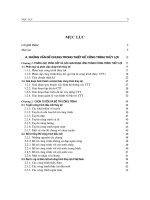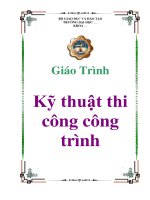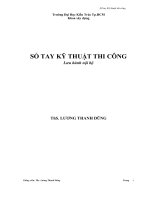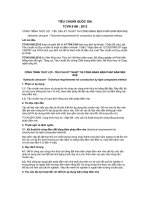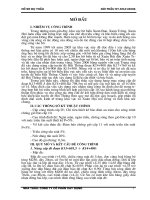Sổ tay kỹ thuật thi công công trình cấp nước
Bạn đang xem bản rút gọn của tài liệu. Xem và tải ngay bản đầy đủ của tài liệu tại đây (10.7 MB, 121 trang )
1
04.2012
THI CÔNG
CÔNG TRÌNH
2012
06/06/2012
Sổ tay Kỹ thuật Thi công Công trình Cấp nước (v.1)
2
TP. HỒ CHÍ MINH – THÁNG 06 NĂM 2012
Sổ tay Kỹ thuật Thi công Công trình Cấp nước (v.1)
3
.
-
+
+ + Fax: +84.38279268
+ Email: ,
,
,
Sổ tay Kỹ thuật Thi công Công trình Cấp nước (v.1)
4
Symbol drawing of water
supply network. 9
I. (Symbol) 9
II. (Symbol details) 9
III. (Valve symbol) 10
IV. (Other details) 10
1.B cha, th(Reservoir, Tanks) 10
(Pump) 11
3.Các chi tit khác (Other details) 12
Technical digging trenchs 13
I. (Principle) 13
II. (Order of execution) 13
1.Chun b mt bng (Ground preparation) 13
2.Ct mng (Cut the tarmac) 13
3.K thung (Technical digging trenchs) 14
3.1. (Digging manual) 14
3.2. (Mechanical digging) 14
(Digging trenchs) 15
5.Ch (Resist digging trenchs) 16
6.Các cách thi công giàn giáo (Construction scaffolding) 17
Transportation and
storage pipes in site 18
I. (Transportation and gathering
in site) 18
II. (General Precautions) . 20
1.Cu ng (Lifting) 20
2.S dng các móc (Use of hooks) 20
III. (Storage) 21
1.ng Gang (Cast Iron pipe) 21
2.ng nha uPVC (uPVC) 22
IV. (Storage conditions) 22
Construction and istallation of pipes 25
I. g (Ductile iron pipe installation) 25
1.Xung (Laying) 25
2.V sinh mi ni (Clean) 25
3.Lp joint vào mi ni (Position the gasket) 25
Sổ tay Kỹ thuật Thi công Công trình Cấp nước (v.1)
5
sâu thúc (Mark the socket depth) 26
5.Tra m i ni (Lubricate) 26
6.Lu ni ng (Assemble) 27
7.Kim tra mi ni (Check) 27
bê tông canh chn ti mi ni (Anchor blocks) 27
9.Mt s bin pháp thi công ng Gang (Pipe laying equipment) 28
9.1. Dùng xà beng (Crowbar) 28
9.2. (Asembly using digger bucket) 29
9.3. (Mechanical winches) 29
II. (HDPE
pipe installation guide (By the method of welding) 31
1.Mt s v c(Some issues to note) 31
2.Công tác chun b c khi hàn (Preparation before welding) 31
3.Thi công hàn ng. (Welded construction) 32
3.1. (Chamfer pipe) 32
3.2. (Welded pipes) 33
3.3. (Weld inspection (by eye)) 33
III. (PVC pipe construction engineering) 35
ng dn lt (Installation Instruction) 35
2.Mt s c bit (A number of special note) 36
1.1. 200mm) (Case 1 (DN 100 –
200mm)) 36
1.2. 50mm) (Case 2 (DN 21 – 50mm))
38
IV. (Installation uPVC pipes) 40
1.Chun b(Preparation tool) 40
2.Lt (Installation) 41
Re – established 44
I. (Filled the trench) 44
II. (Backfilling and tarred) 45
Bolt tightening method 51
I. (Standard Application) 51
1.Trình t công tác lp bu-c thc hi 51
Polyethylene sleeving 54
I. (Conditions of use) 54
II. (Technical characteristics) 54
(Installation process) 54
Sổ tay Kỹ thuật Thi công Công trình Cấp nước (v.1)
6
Repair prestressed
concrete cylinder pipe. 59
I. (Emergency Replacement kit) 59
II. (Welded repair joint) 63
III. (Emergrncy repair saddle) 63
. Flushing
methods are being applied 64
I. (normanlly) 64
1.Nguyên tc thc hin (Principle) 64
tính toán: (Foundation) 65
3.Yêu cu trong quá trình thc hin (Required in the flushing procedure)
66
4.Mt s hn ch và phm vi áp dng (Field of application) 66
II. (Cleaning by polypigs) 68
1.Khái nim (Concept) 68
2.Yêu cu trong quá trình thc hin (Required of the flushing procedure)
69
c hin (Method) 69
4.Phm vi áp dng và hn ch (Field of application and restriction) 70
4.1. (Field of application) 70
4.2. (Restriction) 71
5. m (Advantages) 71
-12. Cut tee and do not
close the water 72
I. -12 (Equipment) 72
II. -12 (Steps in preparing and
operation) 72
25 mm. Menthod of sealing water
meter D15mm – 25mm 84
I. (Prepare) 84
II. (Steps of the press lead) 84
1.Bm chì cho loi ng ngánh OD 25mm (Press lead for pipe industry OD
25mm) 84
2.Bm chì cho ng ngánh OD27(Press lead for pipe industry OD 25mm)
85
III. (Notes) 87
1.X ng ng h c (Thread the wire into the meter
body) 87
Sổ tay Kỹ thuật Thi công Công trình Cấp nước (v.1)
7
2.Kim tra chì sau khi bm (Check lead after press) 87
Repair ductile iron. 88
I. (Cutting of Pipe) 88
1.Kim tra (Inspection) 88
2.Các dụng cụ và thiết bị (Tools and equipment) 88
3.c thc hin (Procedure) 89
II. Correction of Deformed Spigot) 91
1.Kim tra (Inspection) 91
2.Dng c và vt liu (Tools and equipment). 91
3. thc (Procedure) 92
III. (large cracks, deformation of pipe body
is expected) 94
1.Kim tra (Inspection) 94
2.Thao tác (Procedure) 95
IV. (chip) 97
1.Dng cu và thit b (Tools and equipment) 97
2.Kim tra ( Inspection) 97
3.Quy trình (Procedure) 97
V. (Break) 99
1.Các thit b phc vc cho công tác sa sa. Nên dùng các công c (Tools
and convenience of the repair work, use of the following tools is
recommended) 99
2.Kim tra (Inspection) 99
3.Quy trình (Procedure) 99
VI. (Repair of External Coating) 101
1.Dng c, thit b (Tools and equipment) 101
2.c (Procedure) 102
Manual measuring devices 103
I. Panme (Micrometre) 103
1.c m (Characteristics) 103
(Measuring) 103
c tr s (Indicator reading) 104
II. (Calipers) 105
1.c m (Characteristic) 105
2.Phân loi (Sort) 105
Sổ tay Kỹ thuật Thi công Công trình Cấp nước (v.1)
8
III. (The Durometer (A rubber hardness tester)
107
m và công dng (Characteristics and use) 107
2.Gii thiu hai long h so thông dng và các thông s n
(Introduce the Durometer and Technical Specification) 107
2.1. (Mechanical rubber hardness tester) 108
2.2. (Electron rubber hardness tester) 108
3.Các dng h cng gp (The measuring
instruments the Durometer) 108
IV. (Coating Thickness gages) 109
m và công dng (Characteristics and use) 109
2.Gii thiu mt s và các thông s n
(Introduce Coating Thickness gages and Technical Specification) . 109
V. (Niveau) 110
m, công dng và nguyên tc hong (Characteristics, purpose
and principle of operation) 110
2.Cách nhn dng niveau cân bng hay không cân bng (Ways to identify
neveau is balance or imbalance). 111
VI. (Calipers). 112
VII.Com(Inside caliper). 112
(Circumference Tap). 112
113
114
115
116
117
118
(References) 119
Sổ tay Kỹ thuật Thi công Công trình Cấp nước (v.1)
9
trên .
Symbol drawing of water supply network.
I. (Symbol):
1. (Water supply pipeline):
2. (Other lines):
II. (Symbol details):
Sổ tay Kỹ thuật Thi công Công trình Cấp nước (v.1)
10
III. (Valve symbol):
IV. (Other details):
1. (Reservoir, Tanks):
Sổ tay Kỹ thuật Thi công Công trình Cấp nước (v.1)
11
2. (Pump):
Sổ tay Kỹ thuật Thi công Công trình Cấp nước (v.1)
12
3. (Other details):
Sổ tay Kỹ thuật Thi công Công trình Cấp nước (v.1)
13
Technical digging trenchs.
I. (Principle):
vì
trong thao tác l
Do not dig trenchs too wide or narrower than the size allowed for if wide
it will wasting materials and labor, if narrow will cause difficulties in
manipulating pipe and fittings installed.
Digging trenchs must be flat.
II. Trình (Order of execution):
1. (Ground preparation):
General arrangement of space construction based on the general ground
construction engineering design drawings of construction, the
construction sequence items out.
rào
chắn, biển báo
Pay attention to the requirements and safety regulations on construction,
environmental sanitation, dust, noise, fire, security, guaranteed not to
affect operation of the surrounding areas with system barrier system,
warning signs in accordance with
Mark digging
2. (Cut the tarmac):
Sổ tay Kỹ thuật Thi công Công trình Cấp nước (v.1)
14
3. (Technical digging trenchs):
3.1. (Digging manual):
Scope of application: apply to small works (installation of branch
pipes ), the narrow scope of construction, there is no ground to
dig manually operated vehicles
(Tools):
+ chim, xà beng.
With ground level 2, 3: use manderel, crowbar
+ ,
With ground level 1: use shovel
(Digging):
+
Use manderel, crowbar crowbars to break the cable 2
and 3, each 0.2 m layer to avoid falling back into spoon
digging operations and vacant land where construction
and installation of pipe and move
3.2. (Mechanical digging):
Sổ tay Kỹ thuật Thi công Công trình Cấp nước (v.1)
15
Scope of application: For large-scale expose
ensure ground
(Equipment):
(Excavator)
4. (Digging trenchs):
+
n
Digging trenchs must dug to the correct
depth specified by design, if digging deeper
trenchs designed to allow to fill them with
fine soil or sand to a depth regulations,
dress carefully watered to avoid skewing the
pipelines subsidence.
+
Bottom digging trenchs must be clean, flat.
At the positions of fittings, joints, to dig
deeper trench bottom 0,1 m to the entire
body is exposed on the bottom of the pipe
trench.
+
A rocky trench digging deeper and then
filled up with sand flat.
Sổ tay Kỹ thuật Thi công Công trình Cấp nước (v.1)
16
+
t2 x 150 +d.
Correct width to dig trenchs width design
rules. In case of improper design, the bottom
width of trench dug by the formula: 2 x 150
+ d.
+
Width of trench digging may extend over the
bottom of trench to dig ditches for wall slope
to avoid erosion.
+ (Note):
In the case of ditches dug beneath groundwater or storm water
flooding should take measures to shielding measures to avoid
erosion and water pump used for digging ditches dry, If the soil
dug trench bottom is wet due to flooding, dredging clean backfill
soil in both wet and compacted carefully before install tube.
g.
In the case of soft soil can erosion to take measures to shield
walls and ditches dug carefully during construction.
5. (Resist digging trenchs):
(General requirements):
thì
:
(To ensure safety during construction excavation time digging trenchs
must resist digging trenchs to avoid erosion, the excavation time digging
trenchs to support):
+ (Quick assembly).
+ (Make sure the bearing capacity).
+ (Remove easily
after performing finish work).
+
(Make sure the space of need in the area of construction tube
assembly).
Sổ tay Kỹ thuật Thi công Công trình Cấp nước (v.1)
17
6. Các cách thi công giàn giáo (Construction scaffolding):
giáo
(There are many ways of construction scaffolding prop
digging trenchs but commonly used 2 ways).
+ (Horizontal boards
placed).
Advantages: Insert the board quickly.
Defect: Difficult dismantling when
finishing work.
+ (Vertical boards placed):
Advantages:Ease
of construction and dismantling when
complete the work .
ván ngang.
Defect: Consuming more material
horizontal board mounting type.
Sổ tay Kỹ thuật Thi công Công trình Cấp nước (v.1)
18
.
Transportation and storage pipes in site.
I. (Transportation and gathering in
site):
1. (Lifting):
2. (Lifting by hand).
+ cáp (Use of wire rope or nylon
sling).
+
(Enrure the load of pipe and fittings is
correctly balanced so that wire rope or nylon sling does not slip out).
(Pipe: Use of wire rope.
Sổ tay Kỹ thuật Thi công Công trình Cấp nước (v.1)
19
Place cushion pads to protect pipe surface. Do not lift pipe with
single rope. With rubber is highly recommended).
tùng.(Fittings: Use of nylon sling is highly recommended.
Place rubber pieces to avoid rapid abrasion of nylon sling).
3. (Use of hooks):
+ Khi s dng các móc. Cn th các lp va bên trong b
(When using hooks, be careful not to damage the pipe or lining).
+ Móc cn có ming bc bng cao su.(Cover hooks with rubber pieces).
+ u nhn cng lp va ca ng (Make
sure sharp point of hook does not damage the lining).
Sổ tay Kỹ thuật Thi công Công trình Cấp nước (v.1)
20
II. (General Precautions)
1. (Lifting).
.
Use of wire rope or nylon sling.
Enrure the load of pipe and fittings is correctly
balanced so that wire rope or nylon sling does
not slip out.
Pipe: Use of wire rope. Place cushion pads to
protect pipe surface. Do not lift pipe with single
rope. With rubber is highly recommended.
Fittings: Use of nylon sling is highly
recommended. Place rubber pieces to avoid
rapid abrasion of nylon sling
2. (Use of hooks)
When using hooks, be careful not to damage
the pipe or lining.
Cover hooks with rubber pieces.
Sổ tay Kỹ thuật Thi công Công trình Cấp nước (v.1)
21
.
Make sure sharp point of hook does not
damage the lining.
III. (Storage):
1. (Cast Iron pipe).
.
Storage class for a maximum of arrangement (for pipes Class K9).
ARRANGEMENT
(Diamater)
100
150
200
250
300
350
400
450
500
600
700
800
900
1000
Hình Tháp
(TH.1)LOW
58
40
31
25
21
18
16
14
12
10
7
6
5
3
(TH.2,3)
STANDARD
27
22
18
16
14
12
11
10
8
7
5
4
4
3
Sổ tay Kỹ thuật Thi công Công trình Cấp nước (v.1)
22
2. uPVC (uPVC):
Install belled pipe must be arranged
correctly in transport or store.
:
Arrangement metheds :
The belled pipe ends must not touch
together.
1.5m.
Belled pipes must be arranged in the
bracket with height up to 1.5m.
IV. (Storage conditions):
Storage conditions
Pipes
JOINT CAO SU
Rubber gaskets
The storage temperature
25
o
C
(Storage temperature
should be below 25
o
C)
The humidity of the storage
atmosphere
Exposure to light
Do not expose to light
Store in cool and dark.
ánh sáng.
Do not expose to light
Length of storage
06 years after production
Avoid
Avoid slopes or
unstable land place
Avoid muddy, dirty
areas.
No joint is taken out of the
packaging layer.
các
Stay away from solvents,
oils, greases and other
substances degradation.
Sổ tay Kỹ thuật Thi công Công trình Cấp nước (v.1)
23
Avoid directly on the
ground, especially soil
erosion likely.
Should be stored at normal
state, do not pull or strain
compression.
If you can not avoid
distortion, do so in the
short term storage
Storage conditions
Preservation
Tránh
Avoid
The storage temperature
o
C.
Storage temperature
should be below 25
o
C
(The humidity of the
storage atmosphere)
(Exposure to light)
Rubber gasket should
be stored in a cool and
dark place.
ánh sáng.
Do not expose to light.
Length of storage
A maximum of 06 years
after production
Avoid
Please don’t take joints
out of the packaging
-
Rubber gasket should be
kept away from solvent,
oil, grease and other
deterious material.
-
The rubber gasket
should, wherever
possible, be stored in a
relax form free from
Sổ tay Kỹ thuật Thi công Công trình Cấp nước (v.1)
24
tension, compression or
other deformation.
-
If it is impossible to
avoid deformation, it
should be kept to a
minimum.
Storage for comparatively short
periods.
Storage for longer periods.
It s recommended to but the gaskets
in a box or wrap them up in paper,
vinyl sheet or other suitable
material.
Joint must be removed from fire,
chemical, solvent. Do not heap to
avoid variation of joint.
(Gethering pipes in the contruction site).
Gethering pipes and fittings in the
contruction site have to ensure traffic safety
The socket and spigots of pipe have to be
sealed off before laying into trence.
Sổ tay Kỹ thuật Thi công Công trình Cấp nước (v.1)
25
.
Construction and istallation of pipes.
I. g (Ductile iron pipe installation).
1. (Laying):
-
Lower pipes into the trench without damaging them.
- Không .
Do not hit pipe ends against the trench walls.
2. (Clean):
Clean the pipe spigot, inside the
socket and the gasket.
3. (Position the gasket):
.
Insert the gasket before lowering the
pipe into the trench.




